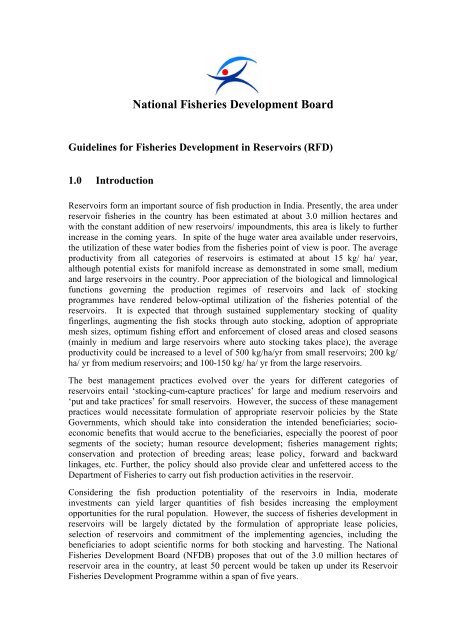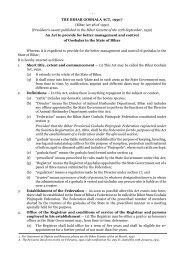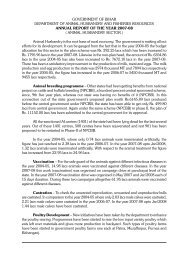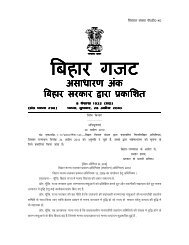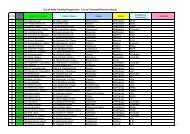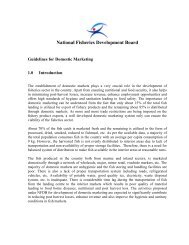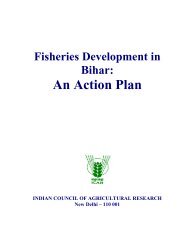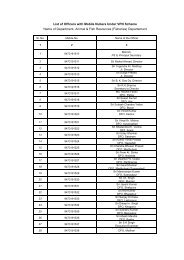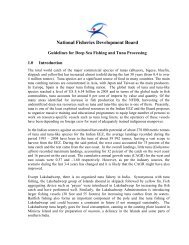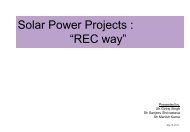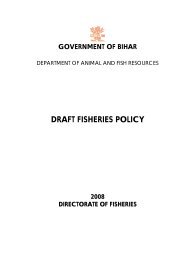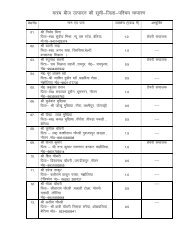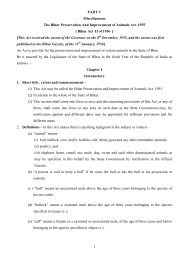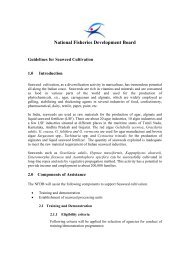National Fisheries Development Board - Animal & Fish Resources
National Fisheries Development Board - Animal & Fish Resources
National Fisheries Development Board - Animal & Fish Resources
Create successful ePaper yourself
Turn your PDF publications into a flip-book with our unique Google optimized e-Paper software.
<strong>National</strong> <strong><strong>Fish</strong>eries</strong> <strong>Development</strong> <strong>Board</strong><br />
Guidelines for <strong><strong>Fish</strong>eries</strong> <strong>Development</strong> in Reservoirs (RFD)<br />
1.0 Introduction<br />
Reservoirs form an important source of fish production in India. Presently, the area under<br />
reservoir fisheries in the country has been estimated at about 3.0 million hectares and<br />
with the constant addition of new reservoirs/ impoundments, this area is likely to further<br />
increase in the coming years. In spite of the huge water area available under reservoirs,<br />
the utilization of these water bodies from the fisheries point of view is poor. The average<br />
productivity from all categories of reservoirs is estimated at about 15 kg/ ha/ year,<br />
although potential exists for manifold increase as demonstrated in some small, medium<br />
and large reservoirs in the country. Poor appreciation of the biological and limnological<br />
functions governing the production regimes of reservoirs and lack of stocking<br />
programmes have rendered below-optimal utilization of the fisheries potential of the<br />
reservoirs. It is expected that through sustained supplementary stocking of quality<br />
fingerlings, augmenting the fish stocks through auto stocking, adoption of appropriate<br />
mesh sizes, optimum fishing effort and enforcement of closed areas and closed seasons<br />
(mainly in medium and large reservoirs where auto stocking takes place), the average<br />
productivity could be increased to a level of 500 kg/ha/yr from small reservoirs; 200 kg/<br />
ha/ yr from medium reservoirs; and 100-150 kg/ ha/ yr from the large reservoirs.<br />
The best management practices evolved over the years for different categories of<br />
reservoirs entail ‘stocking-cum-capture practices’ for large and medium reservoirs and<br />
‘put and take practices’ for small reservoirs. However, the success of these management<br />
practices would necessitate formulation of appropriate reservoir policies by the State<br />
Governments, which should take into consideration the intended beneficiaries; socioeconomic<br />
benefits that would accrue to the beneficiaries, especially the poorest of poor<br />
segments of the society; human resource development; fisheries management rights;<br />
conservation and protection of breeding areas; lease policy, forward and backward<br />
linkages, etc. Further, the policy should also provide clear and unfettered access to the<br />
Department of <strong><strong>Fish</strong>eries</strong> to carry out fish production activities in the reservoir.<br />
Considering the fish production potentiality of the reservoirs in India, moderate<br />
investments can yield larger quantities of fish besides increasing the employment<br />
opportunities for the rural population. However, the success of fisheries development in<br />
reservoirs will be largely dictated by the formulation of appropriate lease policies,<br />
selection of reservoirs and commitment of the implementing agencies, including the<br />
beneficiaries to adopt scientific norms for both stocking and harvesting. The <strong>National</strong><br />
<strong><strong>Fish</strong>eries</strong> <strong>Development</strong> <strong>Board</strong> (NFDB) proposes that out of the 3.0 million hectares of<br />
reservoir area in the country, at least 50 percent would be taken up under its Reservoir<br />
<strong><strong>Fish</strong>eries</strong> <strong>Development</strong> Programme within a span of five years.
2.0 Classification of reservoirs<br />
The size of the reservoirs would be an important determinant of type and amount of<br />
financial investments to be made, likely increments in fish production, generation of<br />
employment, etc. Based on the understanding of the fish production potentiality of<br />
different sizes of reservoirs and their productivity in the country, these water bodies have<br />
been classified into the following size groups:<br />
Categorisation of reservoirs as per water spread area<br />
Sl No. Category Water spread area (in hectare)<br />
1.0<br />
Small reservoirs<br />
Category A 40 - 200<br />
Category B 201 – 1 000<br />
2.0 Medium reservoirs 1 001 – 5 000<br />
3.0 Large reservoirs 5 001 and above<br />
3.0 Implementation of Reservoir <strong><strong>Fish</strong>eries</strong> <strong>Development</strong> Programme<br />
The State Government (Department of <strong><strong>Fish</strong>eries</strong>) shall be the main agency for<br />
implementation of the Reservoir <strong><strong>Fish</strong>eries</strong> <strong>Development</strong> Programme. They will be<br />
responsible for selection of the reservoirs to be developed under the NFDB programme,<br />
leasing of the water body to the beneficiary i.e. the lessee, monitoring and evaluation of<br />
the stocking and harvesting activities, assisting the beneficiaries in establishing sound<br />
forward and backward linkages, providing technical support and in capacity building of<br />
the beneficiaries from time to time. These Guidelines have been developed for the<br />
benefit of the States so that the proposals formulated for assistance under this program<br />
adequately reflect the concept of the <strong>Board</strong> on the various parameters of reservoir<br />
fisheries development in the country.<br />
4.0 Norms for leasing of reservoirs<br />
The lease period and the lease amount is a pre-requisite for sustainable development of<br />
fisheries in the reservoirs. To allow the beneficiaries to develop and sustain fisheries in<br />
the reservoirs, especially those under medium and large categories, a minimum lease<br />
period of five (5) years is necessary. However, a longer lease period of 10-15 years would<br />
be preferable as the beneficiary will have larger stakes in the development of the reservoir<br />
and would not look for short-term gains at the cost of sustainability. Further, the leasing<br />
should be carried out on a competitive basis with only reasonable incentives to<br />
cooperative societies. The State Government, as the recipient of the lease amount, shall<br />
also be required to share 25 percent of the actual lease income or actual license amount or<br />
actual auction amount received on the reservoir in question with the NFDB.<br />
Presently, the lease value for reservoirs is largely determined on historical data of fish<br />
production from the said water body. In most cases this data pertains to the first few<br />
years of impoundment, when the water body generally undergoes a ‘trophic burst’ i.e.<br />
sudden increase in biological productivity leading to greater fish biomass. However, in<br />
the absence of a sustained stocking programme, this ‘trophic burst’ seldom lasts for more<br />
than a couple of years and the long-term ‘trophic depression’ starts and the fish biomass
drops considerably. Any attempt to consider the lease value on the basis of the initial<br />
production (fish biomass) or productivity can be unrealistic and will be a disincentive for<br />
the beneficiary, often leading to failure of repayment, etc. To allow for a more realistic<br />
assessment of the lease value, the following parameters may be taken into consideration:<br />
(i)<br />
(ii)<br />
(iii)<br />
(iv)<br />
(v)<br />
(vi)<br />
(vii)<br />
Water retention time and effective storage level of the reservoirs.<br />
<strong>Fish</strong>ing obstacles in the reservoir.<br />
Spillover problems, especially in the case of small reservoirs.<br />
Conflicting uses with other user agencies of the reservoir water.<br />
Existing fish fauna of the reservoir, with special focus on the availability of<br />
predator species.<br />
Extent of auto stocking in the reservoir.<br />
Average of the last 5-7 years fish production from the reservoir.<br />
5.0 Components of Assistance<br />
The NFDB will assist the following two components to support fisheries development in<br />
the reservoirs:<br />
• Stocking of reservoirs with fingerlings of > 100 mm size.<br />
• Training of beneficiaries<br />
6.0 Norms for stocking of reservoirs<br />
Stocking will be the mainstay of reservoir fisheries development and will facilitate fish<br />
production on sustainable basis. Generally, the Indian major carps comprising fish species<br />
such as Catla catla (catla), Labeo rohita (rohu), Cirrhinus mrigala (mrigal) will form the<br />
core species for stocking of the reservoirs across the country. The implementing agencies<br />
in consultation with the beneficiary may also consider need-based stocking of additional<br />
species such as L. bata, L. calbasu and Ctenopharyngodon idella (grass carp).<br />
As a thumb rule, the small reservoirs and those under medium category where<br />
autostocking is not possible will require a regular stocking programme to use the<br />
productive potential of the water body. In the absence of autostocking, this annual<br />
stocking is essential, otherwise the production potential of the water body shall remain<br />
un/underutilized. The large reservoirs will necessitate supplementary stocking until a<br />
critical mass of breeding population is established in the water body to ensure<br />
replenishment of the stocks that are harvested annually. This category will also include<br />
medium reservoirs where autostocking takes place.<br />
The NFDB programme envisages stocking of the reservoirs with a standard stocking rate<br />
of 1 000 fingerlings. Based on the size of the reservoir, water retention capacity,<br />
prevalence of predators and productive water area, the implementing agency shall have<br />
the flexibility. However, it shall be ensured that this deviation from the standard stocking<br />
rate (1 000 fingerlings per hectare) does not fall below 500 fingerlings per hectare in case<br />
of medium and large reservoirs and above 2 000 fingerlings per hectare in case of small<br />
reservoirs. However the stocking rate shall be limited to 250 fingerlings/ha in large<br />
reservoirs in which the cat fish species are dominating.
7.0 Financial assistance for stocking<br />
The financial assistance to be provided by the NFDB towards stocking of IMC, minor<br />
carps and grass carp fingerlings, of not less than 100 mm, shall be Rupee one (Re 1) per<br />
fingerling. The total number of fingerlings for which funds shall be provided will be<br />
determined on the basis of the effective water area of the reservoir. This cost shall<br />
include all inputs that would go towards the production of the fingerlings on a<br />
commercial basis, whether ex-situ (in land-based nurseries) or in-situ (in pens and cages)<br />
and its transportation to the reservoir site for stocking. The lessee or the Implementing<br />
Agency shall carry out this activity with adequate monitoring and supervision at each<br />
stage to ensure that fingerlings of right size and numbers are stocked in the reservoir.<br />
8.0 Training of beneficiaries<br />
8.1 Introduction<br />
Skill upgradation is an important component of any production-oriented activity.<br />
It assumes more importance when the inherent technical skills/ capacity of the<br />
intended beneficiary is low and thus can be an important attribute of success or<br />
failure of the activity. The NFDB’s objectives of developing fisheries in the<br />
reservoirs can be adversely impacted if the technical skills of the fishermen are<br />
inadequate. Therefore, to meet this important requirement of human resource<br />
development in reservoir fisheries development, the <strong>Board</strong> envisages training to<br />
fishermen who constitute the lessees to whom the water body is leased for fishing<br />
purposes. As it is a training programme linked with the reservoirs funded by the<br />
NFDB, five day training programme is sufficient and dispensed with the<br />
demonstration.<br />
8.2 Unit cost (training)<br />
The unit cost includes a standard training period of five (5) days and the following<br />
activities shall be funded under the programme:<br />
(i) Assistance to fishermen: The fishermen shall be eligible for a daily allowance<br />
of Rs 125/ day and reimbursement of to and fro travel (train/ bus/ auto rickshaw)<br />
shall be reimbursed as per actuals, subject to a maximum of Rs 500.<br />
(ii) Honorarium to resource person: For conduct of training, the Implementing<br />
Agency may engage the services of one resource person per training programme.<br />
The resource person may be given an honorarium of Rs 1 250 and to and fro travel<br />
expenses (train/ bus/ auto rickshaw) shall be reimbursed as per actuals, subject to<br />
a maximum of Rs 1 000.<br />
(iii) Assistance to Implementing Agencies: The implementing agency shall be<br />
eligible to receive Rs 75/ trainee/ day for a maximum period of 5 days for<br />
organizing the training. This cost shall cover expenses towards identification and<br />
mobilization of the trainee and course material/ training kits, etc.<br />
9.0 Submission of proposals<br />
The Implementing Agency shall be required to submit a detailed project proposal to the<br />
NFDB, which shall also incorporate the feasibility of the proposed activity. The proposal<br />
shall be submitted as per Form I (RFD) attached to these Guidelines. To ensure
systematic and orderly evaluation of proposals and their approval from the <strong>Board</strong>, the<br />
Implementing Agencies shall submit the proposal at the beginning of each quarter i.e.<br />
April, July, October and January.<br />
10.0 Release of funds<br />
Generally, funds shall be released in two equal installments. The first installment, not<br />
exceeding 50 percent of the total project cost, shall be released on approval of the<br />
proposal by the NFDB. The second installment shall be released on successful completion<br />
of the stocking of the reservoir and certification by the monitoring committee set up for<br />
each reservoir.<br />
11.0 Monitoring and Evaluation<br />
Since the ultimate success of fisheries development in the reservoirs would be determined<br />
by the stocking programme, it is essential to constitute a committee to monitor the<br />
activities and oversee the stocking of fingerlings in the water body. The said committee<br />
may be constituted involving representatives of the following organizations/ agencies:<br />
(i)<br />
(ii)<br />
(iii)<br />
(iv)<br />
(v)<br />
Representative of the District Revenue Department<br />
Representative of the Irrigation/ Power Department<br />
Representative of the Local Body<br />
Representative of the Lessee<br />
Representative of the Department of <strong><strong>Fish</strong>eries</strong><br />
The Implementing Agency shall also furnish a progress report at the beginning of each<br />
quarter i.e. April, July, October and January on the physical and financial progress of the<br />
activity. The progress report shall provide critical evaluation of the performance,<br />
highlighting the achievements, constraints in implementation, etc.<br />
12.0 Submission of utilization certificates<br />
The Implementing Agencies shall submit utilization certificate in respect of the funds<br />
released to them by the NFDB. Such certificates shall be submitted in Form III (RFD) on<br />
half-yearly basis i.e. during July and January of each year. The utilization certificates can<br />
also be submitted in between if activities for which funds were released earlier have been<br />
completed and the next dose of subsidy is required to complete the remaining works by<br />
the farmer.<br />
13.0 General norms<br />
(i)<br />
(iii)<br />
As a pre-requisite, scheme proposed for development of reservoir fisheries should<br />
be financially viable, socially acceptable, environmentally sound. The technical<br />
parameters proposed in the scheme should be in conformity with the scientific<br />
norms developed for reservoir fisheries. The scheme should be robust to generate<br />
adequate surplus to meet the repaying capacity of the borrower.<br />
The Department of <strong><strong>Fish</strong>eries</strong> shall register all fishing boats and gear and shall<br />
maintain a registry of such boats and gear to estimate the effort deployed in the<br />
reservoir.
(iv)<br />
(vi)<br />
The beneficiary shall maintain full record of stocking of fish fingerlings and other<br />
inputs released into the reservoir and daily records of fish catch harvested for each<br />
unit of boat and the nets used thereof. This data shall be made available to the<br />
State Government and the NFDB at specified intervals.<br />
The beneficiaries, in consultation with the Implementing Agency, make suitable<br />
arrangements for marketing of fish harvested from the reservoir.<br />
(vii) The Implementing Agency must ensure that the beneficiaries are adequately<br />
trained in all aspects of reservoir fisheries such as seed raising and stocking,<br />
efficient use of fishing gear and post-harvest handling of fish.<br />
(viii) The Implementing Agency shall maintain a separate account for the funds<br />
released by NFDB under this activity.<br />
(ix) The implementing agency shall ensure that the stocking and harvesting activities<br />
are taken up as per scientific norms and any harvesting practice that may have<br />
adverse impact on the sustainability of the reservoir fisheries shall not be allowed<br />
by the Implementing Agency. The Implementing Agency shall also strictly<br />
enforce closed season and wherever necessary closed areas in reservoirs where<br />
autostocking takes place to protect the fish brood stock and the juveniles.
FORM – I(RFD)<br />
Application for submission of proposal for financial assistance from<br />
<strong>National</strong> <strong><strong>Fish</strong>eries</strong> <strong>Development</strong> <strong>Board</strong><br />
Sl. No.<br />
Information sought from the Information furnished by the<br />
Implementing Agency<br />
Implementing Agency<br />
(1) (2) (3)<br />
1.0 Name of the Reservoir:<br />
2.0 Name and address of the Lessee (telephone/<br />
mobile numbers):<br />
3.0 If Lessee is a Cooperative Society, please<br />
provide details of the Society:<br />
4.0<br />
Details of the reservoir:<br />
a) State:<br />
b) District(s):<br />
c) Taluk(s)/ Mandal(s):<br />
d) Revenue village(s) located on the<br />
reservoir:<br />
e) Ownership right (whether freehold<br />
or lease hold):<br />
f) If on lease, duration of the lease:<br />
g) Reservoir water spread area (in ha):<br />
Full Storage Level (FSL):<br />
Dead Storage Level (DSL):<br />
h) Average water spread area (in ha):<br />
Details of facilities for stocking of seed:<br />
5.0<br />
6.0<br />
a) Hatcheries:<br />
b) Rearing facilities from spawn to<br />
fingerling of 100 mm size, including<br />
pen culture:<br />
Whether the Lessee is in default of payment o<br />
any Financial Institution/ State Government:
(1) (2) (3)<br />
7.0 Details of craft and gear and other facilities<br />
available with the Lessee:<br />
a) <strong>Fish</strong> landing centres with facilities:<br />
b) Boats, their type and number:<br />
c) Net units, their type and number:<br />
d) <strong>Fish</strong> transport vehicle(s):<br />
e) Other facilities, if any at the<br />
reservoir site:<br />
8.0 Existing production/ ha/ year from the<br />
reservoir:<br />
9.0 Proposed stocking of fingerlings > 100 mm<br />
size during year 1-5 of the project<br />
implementation:<br />
10.0 Expected production/ ha/ year from year 2 -<br />
6 as envisaged by the Implementing<br />
Agency/ Lessee:<br />
11.0 Marketing arrangements proposed by the<br />
Implementing Agency/ Lessee:<br />
12.0 Annual lease rent fixed by the State<br />
Government:<br />
13.0 Mode of payment of annual lease amount by<br />
the lessee to the State Government:<br />
14.0 Projected repayment by the State<br />
Government to NFDB during year 2 - 6 of<br />
project implementation:<br />
15.0 Any other information which the<br />
Implementing Agency/ Lessee may like to<br />
furnish:<br />
Date:<br />
Place:<br />
Signature and seal of the authorized<br />
representative<br />
of the Implementing Agency
FORM – II(RFD)<br />
Application for Training under Reservoir <strong>Fish</strong>ery <strong>Development</strong><br />
Sl.<br />
No<br />
Particulars sought from the Implementing<br />
Agency<br />
Information furnished by the<br />
Implementing Agency<br />
(1) (2) (3)<br />
1.0 Name and address of the Implementing<br />
Agency:<br />
2.0 Location of the Training Facility:<br />
District Block Village<br />
3.0 Facilities available or proposed for<br />
imparting training:<br />
4.0<br />
Details of the reservoir:<br />
Name of the name of reservoir<br />
Water spread area of the reservoir<br />
5.0<br />
Mode of fishing method<br />
(Licensing/lease/auction/others)<br />
Expected fish production from the reservoir<br />
a) Existing fish production per (ha):<br />
b) Expected fish production per ha<br />
area by fishermen after training<br />
6.0 Average fish production in the area (kg/<br />
ha/ annum):<br />
No of fishermen depending on the<br />
reservoir<br />
No of fishermen to be proposed for<br />
training<br />
No of days of training<br />
Whether the trainees underwent any<br />
training program before 6 months.
Financial Implications<br />
Item Number Amount<br />
i) Assistance to farmer @ Rs 125/ day<br />
for 10 days:<br />
(ii) Reimbursement of to and fro travel<br />
expenses to farmer:<br />
(iv) Honorarium to resource persons and<br />
reimbursement of to and fro travel<br />
expenses:<br />
(iii) Assistance to implementing agency<br />
@ Rs 75/ trainee/ day:<br />
Total of (a)<br />
11.0 Technical capabilities of resource persons<br />
to be engaged in training:<br />
12.0 Any other details in support of the proposal<br />
Date:<br />
Place:<br />
Agency<br />
agency<br />
Signature of the Implementing<br />
Seal and address of the implementing
FORM – III(RFD)<br />
Form for Submission of Utilization Certificate<br />
Sl. No Letter No and date Amount<br />
Certified that out of Rs ___________<br />
sanctioned during the year_________<br />
in favour of _______ under the<br />
<strong>National</strong> <strong><strong>Fish</strong>eries</strong> <strong>Development</strong><br />
<strong>Board</strong>’s Letter No given in the margin<br />
and Rs _____________ on account of<br />
unspent balance of the previous<br />
sanction, a sum of Rs ___________ has<br />
been utilized for the purpose<br />
of____________ for which it was<br />
sanctioned and that the balance of Rs<br />
___________ remains unutilized. The<br />
same will be adjusted towards the next<br />
installment payable during the<br />
period________.<br />
2.0 Certified that I have satisfied myself that the conditions on which the funds<br />
were sanctioned by the <strong>National</strong> <strong><strong>Fish</strong>eries</strong> <strong>Development</strong> <strong>Board</strong> have been duly<br />
fulfilled/ are being fulfilled and that I have exercised the following checks to see<br />
that the money was actually utilized for the purpose for which it was<br />
sanctioned.<br />
Date:<br />
Place:<br />
Signature and seal of the<br />
authorized representative of the<br />
Implementing Agency


